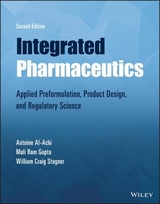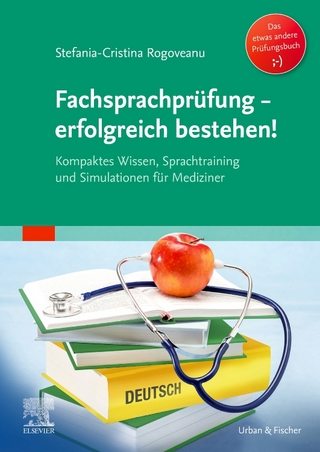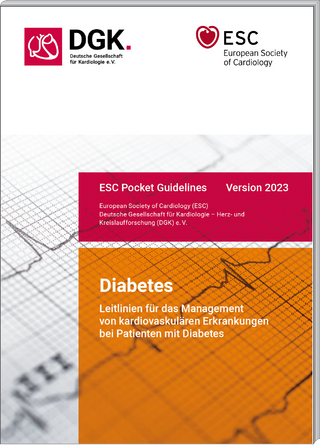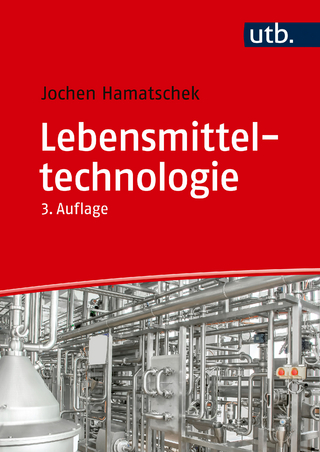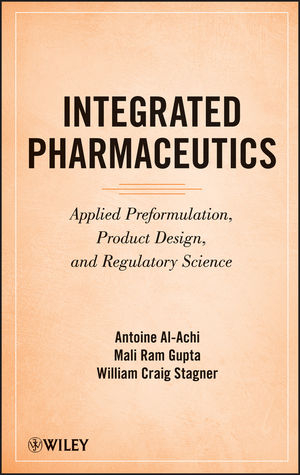
Integrated Pharmaceutics – Applied Preformulation, Product Design, and Regulatory Science
John Wiley & Sons Inc (Verlag)
978-0-470-59692-0 (ISBN)
- Titel erscheint in neuer Auflage
- Artikel merken
Focusing on the application of physical pharmacy, drug design, and drug regulations as they relate to produce effective dosage forms for drug delivery, Integrated Pharmaceutics provides a comprehensive picture of pharmaceutical product design, describing the science and art behind the concepts of dosage form development. Combining physical pharmacy, product design, and regulatory affairs issues in a single book, the authors address topics governing drug regulations of United States, European, and Japanese agencies and detail new regulatory guidelines, including quality by design, design space analysis, and blend sample uniformity.
ANTOINE AL-ACHI, PhD, CT (ASCP), is Associate Professor of Pharmaceutics in the College of Pharmacy & Health Sciences at Campbell University. He is also the former head of the Formulation Development Division of Campbell's Pharmaceutical Sciences Institute (CUPSI). MALI RAM GUPTA, PhD, is Associate Professor of Pharmaceutical Sciences and Director of Pharmaceutical Education & Research Center (PERC) in the College of Pharmacy & Health Sciences. Prior to joining the faculty at Campbell University, he spent twenty-five years in various positions at Revlon, including director of quality control and assurance. WILLIAM CRAIG STAGNER, PhD, RPh, is Professor of Pharmaceutical Sciences and Director of Campbell University's Center for Analysis of Pharmaceutical Biomaterials. Prior to joining the faculty at Campbell, he established the Pharmaceutics Department at Glaxo Research Institute.
FOREWORD xv PREFACE xvii PART I PREFORMULATION CHAPTER 1 MATHEMATICAL CONCEPTS 3 1.1 Introduction 3 1.2 The Simple Linear Relationship 4 1.3 Exponential Rules 7 1.4 Logarithmic Rules 8 1.5 Differential Equations 10 1.6 Expanding and Reducing Formulas 12 References 13 Glossary 14 CHAPTER 2 THERMODYNAMICS 15 2.1 Introduction 15 2.2 The Zeroth Law of Thermodynamics 15 2.3 The First Law of Thermodynamics 16 2.4 The Second Law of Thermodynamics 17 2.5 The Third Law of Thermodynamics 18 2.6 Polymorphism 18 2.7 Physical Stability of Crystal Forms 20 2.8 Solubility 21 References 22 Glossary 23 CHAPTER 3 SOLUBILITY AND DISSOLUTION 25 3.1 Introduction 25 3.2 Concentration Units 26 3.3 What Should be Done When Alcohol is Prescribed in a Formulation 35 3.4 The Partition Coefficient 36 3.5 Disintegration and Dissolution 38 3.6 Concluding Remarks 43 References 43 Glossary 44 CHAPTER 4 BIOLOGICAL ASPECTS OF FORMULATIONS 45 4.1 Introduction 45 4.2 Bioavailability and Bioequivalence 45 4.3 Protocols for Determining Bioequivalence 49 4.4 Bioequivalence Procedure 49 4.5 FDA-Approved Methods for Bioequivalence Studies 50 4.6 Approaches to Improving Bioavailability 52 References 54 Glossary 54 CHAPTER 5 INTERFACIAL PROPERTIES 57 5.1 Introduction 57 5.2 Liquid Solid Interface 58 5.3 Dosage-Form Applications 58 References 63 Glossary 63 CHAPTER 6 ADSORPTION PHENOMENON 65 6.1 Introduction 65 6.2 Adsorption on Filters 68 6.3 Adsorption of Proteins 69 References 70 Glossary 71 CHAPTER 7 RHEOLOGICAL PRINCIPLES 73 7.1 Introduction 73 7.2 Newtonian Systems 74 7.3 Non-Newtonian Systems 75 7.4 Viscoelasticity 78 7.5 Reynolds Number 81 7.6 Concluding Remarks 81 References 82 Glossary 82 CHAPTER 8 CHEMICAL STABILITY AND SHELF-LIFE DETERMINATION 85 8.1 Introduction 85 8.2 Shelf-life Determination 86 8.3 Stability of Biotechnology Products 112 References 113 Glossary 117 CHAPTER 9 PARTICLE SCIENCE 119 9.1 Introduction 119 9.2 Particle Size Estimation and Distribution 120 9.3 Micronization 125 9.4 Particle Size Preparation and Reduction for Pulmonary Delivery 126 9.5 Polymeric Particulate Matter 128 9.6 Nanoparticles 128 9.7 Segregation of Particles 131 References 132 Glossary 133 CHAPTER 10 BASIC STATISTICS AND DESIGN OF EXPERIMENTAL CONCEPTS 135 10.1 Descriptive Statistics 135 10.2 Inferential Statistics 137 10.3 Statistical Applications in Quality Control Testing 146 10.4 Design of Experiment 148 References 154 Glossary 154 CHAPTER 11 FORMULATION DEVELOPMENT CONCEPTS 157 11.1 Preformulation 157 11.2 Scale-up Considerations 158 11.3 Combination Products 159 11.4 Rate-Controlled Drug Delivery 160 11.5 Drug Delivery Technologies for Improving Oral Delivery 163 11.6 Drug Delivery Technologies for Improving Transmucosal Delivery 165 11.7 Drug Delivery Technologies for Transdermal Delivery 166 11.8 Special Considerations for Biotechnology and Protein Delivery Systems 166 11.9 Drug Excipient and Excipient Excipient Interactions 170 11.10 The Presence of Contaminants in a Formulation 172 11.11 Other Considerations 173 References 174 Glossary 176 PART II PRODUCT DESIGN CHAPTER 12 THE PRODUCT DESIGN PROCESS 181 12.1 Introduction 181 12.2 Formulation Design 183 12.3 Process Design 188 12.4 Container Closure System Design 190 References 192 Glossary 193 Appendixes 194 CHAPTER 13 TABLET PRODUCT DESIGN 215 13.1 Introduction 215 13.2 Formulation Design 222 13.3 Process Design 243 13.4 Container Closure System Design 283 13.5 Risk Management 292 13.6 Attribute Tests 293 13.7 New Drug Application Stability Assessment 296 References 298 Glossary 304 Appendixes 306 CHAPTER 14 CAPSULE PRODUCT DESIGN 319 14.1 Introduction 319 14.2 Hard-Shell Capsules 320 14.3 Soft-Shell Capsules 343 14.4 Formulation and Process Optimization 348 14.5 Container Closure System 350 14.6 Risk Management 350 14.7 Attribute Tests 350 14.8 New Drug Application Stability Assessment 352 References 353 Glossary 355 Appendixes 356 CHAPTER 15 DISPERSED SYSTEM PRODUCT DESIGN 359 15.1 Introduction 359 15.2 Formulation Design 360 15.3 Process Design 399 15.4 Container Closure System Design 401 15.5 Risk Management 402 15.6 Attribute Tests 402 15.7 New Drug Application Stability Assessment 405 References 406 Glossary 408 Appendixes 409 CHAPTER 16 AEROSOL PRODUCT DESIGN 415 16.1 Introduction 415 16.2 Formulation Design 416 16.3 Container Closure System Design 443 16.4 Risk Management 446 16.5 Attribute Tests 450 16.6 New Drug Application Stability Assessment 455 References 458 Glossary 462 Appendix 463 CHAPTER 17 STERILE INJECTABLE PRODUCT DESIGN 467 17.1 Introduction 467 17.2 Formulation Design 468 17.3 Process Design 511 17.4 Container Closure System Design 530 17.5 Risk Management 535 17.6 Attribute Tests 535 17.7 New Drug Application Stability Assessment 536 References 539 Glossary 546 Appendixes 548 CHAPTER 18 OPHTHALMIC PRODUCT DESIGN 561 18.1 Introduction 561 18.2 Formulation Design 565 18.3 Process Design 577 18.4 Container Closure System Design 577 18.5 Attribute Tests 577 18.6 New Drug Application Stabilty Assessment 578 References 578 Glossary 580 Appendix 581 CHAPTER 19 TRANSDERMAL PRODUCT DESIGN 587 19.1 Introduction 587 19.2 Formulation Design 590 19.3 Conclusions 612 References 613 Glossary 615 Appendix 615 CHAPTER 20 ORAL MODIFIED-RELEASE PRODUCT DESIGN 619 20.1 Introduction 619 20.2 Coatings 625 20.3 Matrix Systems 628 20.4 Gastroretentive Devices 631 20.5 Osmotic Controlled Release Systems 632 20.6 Conclusions 633 References 634 Glossary 635 Appendix 636 PART III REGULATORY SCIENCE CHAPTER 21 REGULATORY PRACTICES AND GUIDELINES 639 21.1 Worldwide Regulatory Agencies 639 21.2 Good Manufacturing Practice 651 21.3 FDA Inspection and Regulatory Actions 685 References 687 Glossary 689 CHAPTER 22 REGULATIONS FOR COMPOUNDING PHARMACIES 697 22.1 Introduction 697 22.2 Compounding Guidelines 698 22.3 FDA Compliance Policy Guides 699 22.4 Good Compounding Practices 705 22.5 Stability Criteria and Beyond-Use Dating of Compounded Preparations 717 22.6 Verification 719 22.7 Patient Counseling 719 22.8 Pharmacy Compounding Accreditation 720 References 720 Glossary 721 Appendixes 722 CHAPTER 23 IND AND NDA PHASE-APPROPRIATE NEW DRUG DEVELOPMENT PROCESS 727 23.1 Introduction 727 23.2 Preclinical Development Overview 728 23.3 Phase-Appropriate Clinical Trials Overview 730 23.4 Investigational New Drugs 734 23.5 NDA Review Process 744 References 750 Glossary 751 CHAPTER 24 GENERICS, BIOSIMILARS, AND OTCS 753 24.1 Generic Drugs 753 24.2 Biosimilar Drugs 759 24.3 Over-the-Counter Drugs 760 References 767 Glossary 769 Appendix 769 CHAPTER 25 ACCELERATED NEW DRUG APPROVAL AND EXPEDITED ACCESS OF NEW THERAPIES 773 25.1 Introduction 773 25.2 Expedited Review and Approval of New Therapies 774 25.3 Expanded Access to New Therapies 776 25.4 Orphan Drugs 778 25.5 Pediatric Drugs 780 25.6 Pediatric Drug Development and the Orphan Drug Act Incentives 783 25.7 Common EMEA/FDA Application for Orphan Medicinal Product Designation 784 References 784 Glossary 785 CHAPTER 26 POST DRUG APPROVAL ACTIVITIES 789 26.1 Postmarket Requirements and Commitments 789 26.2 Postapproval Manufacturing Changes 790 26.3 Clinical Phase 4 Studies: Postmarketing Surveillance and Risk Assessment 792 26.4 Prescription Drug Advertising and Promotional Labeling Direct to Consumers 798 References 799 Glossary 801 Appendix 804 CHAPTER 27 DRUG MASTER FILES AND EU DOSSIERS 805 27.1 Drug Master Files 805 27.2 European Marketing Authorization Dossiers 817 References 822 Glossary 824 CHAPTER 28 COMMISSIONING AND QUALIFICATION 829 28.1 Regulatory Requirements 829 28.2 Preliminary C&Q Activities 832 28.3 Commissioning 834 28.4 Qualification and Validation 838 28.5 Qualification Protocols 842 28.6 Process Validation 849 28.7 Cleaning Validation 854 28.8 Computer Systems Validation 856 28.9 Change Control 856 28.10 Revalidation 857 References 857 Glossary 859 CHAPTER 29 QUALITY SYSTEMS AND CONTROLS 863 29.1 Pharmaceutical Quality System 863 29.2 Quality Systems Approach to CGMP Regulations 868 29.3 Inspection of Pharmaceutical Quality Control Laboratories 875 29.4 Pharmacopeias 877 29.5 Analytical Instrument Qualification 881 29.6 Validation of Analytical Procedures 886 29.7 Stability Testing of New Drug Substances and Products 889 References 893 Glossary 895 Appendixes 900 CHAPTER 30 SAFETY, TOXICOLOGY, AND PHARMACOGENOMICS 911 30.1 Nonclinical Safety Studies 911 30.2 Safety Pharmacology Studies 914 30.3 Carcinogenicity Studies of Pharmaceuticals 918 30.4 Genotoxicity Testing 920 30.5 Immunotoxicity Studies 923 30.6 Safety Reporting Requirements 926 30.7 Pharmacogenomics 927 References 930 Glossary 932 Appendixes 935 CHAPTER 31 REGULATORY SCIENCE INITIATIVES FOR ADVANCING PUBLIC HEALTH 939 31.1 Introduction 939 31.2 Advancing Regulatory Science for Public Health: The Promise of Regulatory Science 940 31.3 Advancing Regulatory Science at FDA: Strategic Plan for Regulatory Science 940 31.4 Collaborative Implementation Framework 943 References 944 Glossary 945 INDEX 947
| Erscheint lt. Verlag | 15.3.2013 |
|---|---|
| Verlagsort | New York |
| Sprache | englisch |
| Maße | 163 x 252 mm |
| Gewicht | 1464 g |
| Themenwelt | Medizin / Pharmazie ► Medizinische Fachgebiete |
| Naturwissenschaften ► Chemie | |
| Technik ► Umwelttechnik / Biotechnologie | |
| ISBN-10 | 0-470-59692-9 / 0470596929 |
| ISBN-13 | 978-0-470-59692-0 / 9780470596920 |
| Zustand | Neuware |
| Informationen gemäß Produktsicherheitsverordnung (GPSR) | |
| Haben Sie eine Frage zum Produkt? |
aus dem Bereich
